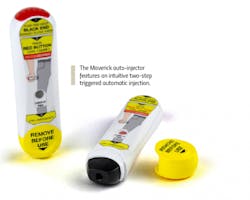Oral solid dose may be the backbone of pharma, but recent innovations in drug delivery products are making it easier for patients and pharma companies to utilize alternatives.
“Tablets and gel capsules are compact and convenient for storage and transportation, yet many consumers have difficulty swallowing pills,” explains Bhaumik Patel, director of New Technology for CURE Pharmaceutical. “There are also limitations on the amount of active ingredients that can be delivered due to the size of these dose forms.”
Here’s a look at how innovations for injectables and chewables are improving the landscape of drug delivery options in pharma.
Next-gen chewables
Since gummies have hit the scene, their soft chewable texture have provided a more pleasant patient experience. But the downsides of gummies have prevented wider adoption in pharma.
“Gummies or chewable gels have significant limitations such as poor thermostability that leads to shorter product shelf life and loss of active material throughout the manufacturing process,” Patel explains. “This lack of consistent quality and the cost of scaling up a new manufacturing process are part of why there is a slow adoption of soft chewable pharmaceutical dose forms.”
To overcome these challenges, CURE recently innovated a new line of chewables (pictured above) using its CUREpod technology platform that is capable of encapsulating and stably retaining a wide range of liquid and solid active ingredients. According to the company, CUREpods are made by forming the complexation of polymers stabilized by chemical crosslinking, and can include different layers of API with distinct release profiles.
“These chewables have a low manufacturing cost and improved stability,” Patel says. “Their texture and consistency are designed to be organoleptically pleasing for improved patient adherence while balancing child safety risks.
ER auto injectors
When an emergency strikes, administering medications quickly can be critical to saving lives, making the need for an easy-to-use injector all the more important. But the fragmented supply chain for injectors can make the process for finding the most reliable choice all the more challenging.
“Although there are already many effective and proven emergency-use devices in the market today, demand is increasing steadily and concerns about supply and robustness have also been highlighted in recent years,” explains Steven Kaufman, vice president of Drug Delivery Systems for the Stevanato Group.
Stevanato Group recently partnered with Duoject Medical Systems to create a single-source for the companies’ Maverick emergency-use auto injector solution. Designed by Duoject and co-manufactured by both companies, the Maverick features a cartridge-based auto-injector with an intuitive two-step triggered automatic injection and needle retraction. According to Kaufman, the Maverick comes with a user-friendly design and is made with reliable technology.
“Mechanical robustness is a key feature of Maverick, utilizing a highly resistant glass cartridge, which makes it suitable for emergency use where effective and fast intramuscular injection is required,” Kaufman says.
With this new collaboration, Stevanato and Duoject are able to provide biopharmaceutical clients a more comprehensive “one stop shop” solution for their critical medications.
Customizable components
Getting the small details right for drug delivery can make a big difference when it comes to quickly bringing products to market.
“With the steady rise of FDA approvals, continued generic competition and global pricing pressures, speed to market is becoming increasingly important for manufacturers who need to quickly produce different products in their portfolios,” Fran DeGrazio, chief scientific officer, Strategy & Science Integration, West Pharmaceutical Services, says.
To meet this need, West’s AccelTRA component program was developed to provide a robust, efficient platform of components that are compatible with a broad variety of generic drug molecules and chemicals.
“The program enables generic drug manufacturers the possibility of offering delivery options and packaging for a variety of molecules leveraging a single formula platform,” DeGrazio says.
West recently expanded its AccelTRA components program with two line extensions featuring ready-to-sterilize and ready-to-use configurations using high-performing elastomer.
“Both product lines leverage the next-generation elastomer formula of 4031/45, which features 13mm and 20mm serum and lyo stoppers in eight configurations, offering generics customers optimal quality, speed and simplicity to help get their products to market quickly,” the company says.
Controlling release
Formulating large biological APIs such as proteins and large peptides into long acting sustained release formulations has traditionally been a challenge for pharma, according to Andrew Bulpin, head of Process Solutions, MilliporeSigma. But innovating sustained release solutions can save costs and be a blessing to patients.
“Sustained release solutions offer important advantages over conventional formulations, such as reduced dosing frequency and decreased side effects,” Bulpin says.
Using MilliporeSigma’s SynBiosys technology platform, pharma companies can encapsulate sensitive biological therapeutics and better control the drug’s release. MilliporeSigma says that the SynBiosys solution can work for virtually any class of biological API and help eliminate development hurdles.
“We have demonstrated conserved protein bioactivity after release from the formulation,” Bulpin says. “The technology can be used for subcutaneous, intramuscular and site-specific injectable formulations in the form of microparticles.”

